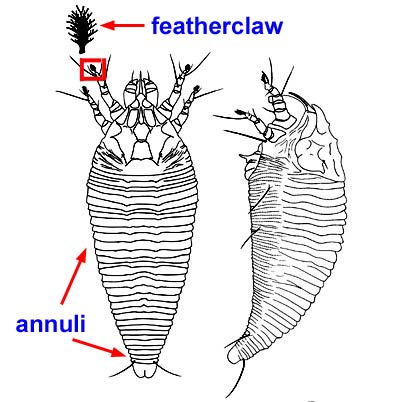Eupodides: Eriophyoidea
Superorder Acariformes
Order Trombidiformes
Suborder Prostigmata
Supercohort Eupodides
Cohort (Superfamily): Eupodina (Bdelloidea, Eupodoidea, Halacaroidea, Tydeoidea, Eriophyoidea)
Superfamily Eriophyoidea (=Tetrapodili)
Common names: gall mites, blister mites, bud mites, rust mites, erinose mites, eriophyoids
Probability of Encounter: very high
Quarantine importance:
Very high. The Eriophyoidea contains many important pests of crops,
including species that transmit plant diseases, especially viruses.
Diagnosis.
Minute, wormlike, fusiform, or rarely flattened or lobulate mites with annulate bodies bearing only 2 pairs of legs; body usually 0.12 mm long
or less (rarely to 0.5 mm) and white to yellowish.
Palps minute, weakly 4-segmented, closely appressed to stylets, truncate
apically; mouthparts composed of 7-9 minute stylets
encased in infracapitular gutter. Prodorsal shield present and bearing 0,
1, 2, 3, 4 or 5 setae; trichobothria absent. Peritremes absent; naso
absent; distinct eyes absent. Opisthosoma
annulate,
setation reduced (maximum = 7 pairs of 'dorsal' setae: c1, c2,
d, e, f, h1, h2 and 4 pairs of coxisternal
setae: 1b, 1a, 2a, 3a [=genital seta].)
Leg setation highly reduced (maximum of 0-1-1-1-3 setae on trochanter, femur,
genu, tibia, tarsus, respectively); tarsus without lateral claws, empodium in
form of highly branched featherclaw. Females have a genital flap posterior
to coxae of legs II and lay spherical eggs; genital papillae absent. Males
have reduced genital flaps and
produce stalked spermatophores.
Similar taxa. Immature Tarsonemidae have 3 pairs of legs and a gnathosomal capsule. Nematalycidae have 4 pairs of legs in post-larval instars.
Ecology & Distribution. The Eriophyoidea (gall and rust mites) consists of more than 3500 described species in > 300 genera, all of which are plant parasites. Most are tiny vermiform animals and bear only two pairs of legs in all active stages (larva, nymph and adult). Some species have two adult female forms, a normal feeding form (protogyne) and an overwintering or otherwise aestivating form (deutogyne).
References
Amrine Jr, JA. 1996. Keys to the World Genera of the Eriophyoidea. Indira Publishing House, West Bloomfield, MI.
Amrine Jr, JW. & TA Stasny. 1994. Catalog of the Eriophyoidea (Acarina: Prostigmata) of the world. Indira Publishing House: West Boomfield, Michigan.
Kethley JB.
1982. Acariformes. In: Parker, S.P. (ed.) Synopsis and Classification of Living
Organisms. McGraw-Hill, New York,
pp. 120-123.
Krantz GW. 1978. A Manual of Acarology. OSU Bookstores: Corvallis.
Lindquist EE, MW Sabelis & J Bruin. 1996. Eriophyid Mites. Their Biology, Natural Enemies and Control. Amsterdam, Elsevier.